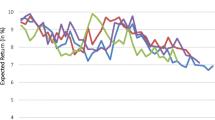Abstract
We show that if firms locate on a circle according to a uniform distribution, their market shares will be beta distributed. The result implies that concentration ratios will be skewed. We apply the result to the market for auditing services in the US and show the beta distribution outperforms other relevant distributions.
Similar content being viewed by others
References
Anderson, S. P. (1986), ‘Equilibrium Existence in the Circle Model of Product Differentiation’, in G. Norman (ed.),Spatial Pricing and Differentiated Markets, Pion Ltd., London.
Cox, D. R. and D. V. Hinkley (1974),Theoretical Statistics, Chapman and Hall, London.
David, H. A. (1970),Order Statistics, John Wiley & Sons, New York, NY.
DeAngelo, L. E. (1981), ‘Auditor Independence, “Low Balling”, and Disclosure Regulation’,Journal of Accounting and Economics 3, 113–127.
Economides, N. (1989), ‘Symmetric Equilibrium Existence and Optimality in Differentiated Product Markets’,Journal of Economic Theory 47, 178–194.
Francis, J. R. and D. T. Simon (1987), ‘A Test of Audit Pricing in the Small-Client Segment of the U.S. Audit Market’,The Accounting Review 62, 145–157.
Ireland, N. J. (1989), ‘Random Entry and Excessive Variety’, Mimeo, University of Warwick.
Jarque, C. M. and A. K. Bera (1980), ‘Efficient Tests for Normality, Homoscedasticity and Serial Independence of Regression Residuals’,Economic Letters 6, 255–259.
Martin, S. (1993),Advanced Industrial Economics, Blackwell.
Mauldon, J. G. (1951), ‘Random Division of an Interval’,Proceedings of the Cambridge Philosophical Society 57, 331–336.
Minyard, D. H. and R. H. Tabor (1991), ‘The Effect of Big Eight Mergers on Auditor Concentration’,Accounting Horizons 5, 79–90.
Parker, S. C. (1991), ‘Significantly Concentrated Markets. Theory and Evidence for the U.K.’,International Journal of Industrial Organization 9, 585–590.
Palmrose, Z-V. (1986), ‘Audit Fees and Auditor Size: Further Evidence’,Journal of Accounting Research 24, 97–110.
Public Accounting Report (1992), ‘E&Y America's Top Accountant’,Public Accounting Report, July 15, 1992.
Sleuwaegen, L. and W. Dehandschutter (1986), ‘The Critical Choice Between the Concentration Ratio and the H-Index in Assessing Industry Performance’,Journal of Industrial Economics 35, 193–208.
Tirole, J. (1988),The Theory of Industrial Organization, MIT Press, Cambridge, MA.
Author information
Authors and Affiliations
Additional information
The authors thank John Hartigan, Norman Ireland, William Shepherd, and an anonymous referee for valuable comments and Chul Park for research assistance.
Rights and permissions
About this article
Cite this article
Hviid, M., Villadsen, B. Beta distributed market shares in a spatial model with an application to the market for audit services. Rev Ind Organ 10, 737–747 (1995). https://doi.org/10.1007/BF01024305
Issue Date:
DOI: https://doi.org/10.1007/BF01024305




